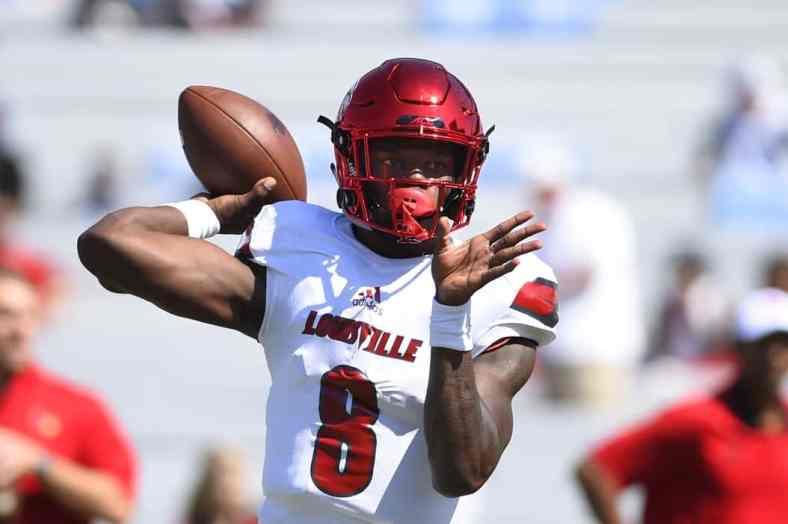
It happens every year. Top prospects, for various reasons, end up taking a huge tumble when names start flying off the board. And it’s going to happen again in the 2018 NFL Draft.
So, who might take a big fall in this year’s draft?
We can think of a few high-profile quarterbacks who fit that mold. Some dynamic defenders have struggled during the pre-draft process and could end up being bargains in the end. A couple of offensive linemen who have excellent potential could also find themselves in a free fall.
The following players could be waiting much longer than they anticipated to find new homes at the NFL level.
Ronald Jones II, running back, USC
After a disastrous combine in which he pulled up lame with a hamstring injury on his first 40 attempt, Jones had a chance to redeem himself during his pro day at USC. Unfortunately, the star running back still wasn’t fully healthy and was unable to complete all his drills. Compounding matters, he struggled with drops in the rain and generally made a poor impression.
Jones is going to hold a second pro day for scouts ahead of the draft. But given the fact there were already some concerns about his size (5-foot-11 and just 200 pounds), these developments could have Jones shooting down the board come draft day. He has home-run speed and rushed for 1,590 yards last year. But teams will be concerned about his durability and will question whether he’s capable of handling a big load at the NFL level.
Orlando Brown, offensive tackle, Oklahoma
Perhaps no prospect had a worse combine than Brown did. The Oklahoma product was out of shape, putting up bottom-of-the-barrel numbers in every drill he did. Making matters worse, coaches were jumping all over him for loafing during the field drills (more on all that here).
While he was fantastic at keeping Baker Mayfield clean on passing plays during his tenure with the Sooners, Brown may have trouble with top pass rushers at the next level. He tends to lunge and bend his waist, which is a big no-no, and his functional strength doesn’t match his massive 6-foot-8, 360-pound frame. Brown did a bit better during his pro day than he did at the combine. But before it he was considered by many to be a lock as a first-round pick. Now there’s talk about him potentially sliding into the second half of Day 2.
Joshua Jackson, cornerback, Iowa
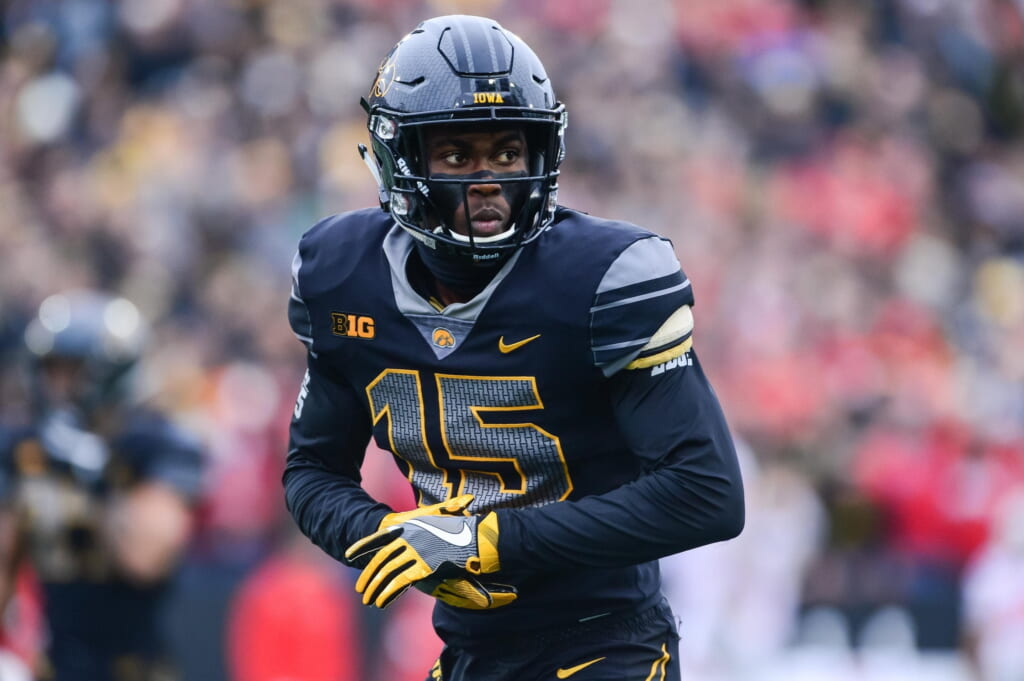
Was Jackson a one-year wonder at Iowa? It’s a legitimate question. He started just 14 games during his college career, and while he did have an outstanding junior campaign it’s safe to wonder whether he has the athleticism to become an elite NFL cornerback.
Jackson doesn’t have top-end speed, not like the other top cornerbacks in this draft. His time of 4.56 seconds in the 40 was slower than scouts were expecting. Even more worrisome is the fact that he wasn’t great in the 3-cone drill, which tests lateral quickness and burst. On top of that, Jackson wasn’t one of the smoothest cornerbacks during the on-field drills at Lucas Oil Stadium.
With all that being said, it won’t be surprising to see Jackson slide well into the second round. If he proves his final season at Iowa wasn’t a mirage, then perhaps he’ll end up being a steal. But at this time, teams have to be wondering about his ability to translate to the next level.
Lamar Jackson, quarterback, Louisville
There are a few big reasons why Jackson will almost certainly be the “top” quarterback in this draft who falls the hardest.
First off, there’s a perception that Jackson isn’t mechanically sound and will become an interception machine as a pro. There’s some truth to the mechanics issue. He tends to rely on his otherworldly athleticism and strong arm at times, leading to throws that sail and will lead to big plays for opposing NFL defenses.
The second issue is more troublesome. And it’s not exactly fair. Teams wonder if Jackson should switch positions and become a wide receiver. After all, he’s an unbelievable athlete, and his open-field abilities are legendary (here’s a great example). So if he’s not seen by teams that need a quarterback as a pure quarterback, he’ll fall.
Finally, and this is the most worrisome aspect right now, Jackson has no agent and is reportedly hard to reach for NFL teams. So, a big fall could be in store for the former Heisman winner.
Derrius Guice, running back, LSU
During his tenure at LSU, Guice never had any major off-field issues that were reported. However, a former scout sent out a tweet on Wednesday saying “it sounds like off-field will be more of an issue for Guice than I originally thought.”
That could mean there is some concern about Guice’s character, nevertheless, even though the news surrounding him of late has been extremely positive. Then there’s the issue of Guice having dealt with injury issues at college. Given the fact that running backs tend to fall in the draft anyway, and that this year’s class is absolutely stacked, this could mean a bit of a drop for Guice on draft day.
Calvin Ridley, wide receiver, Alabama
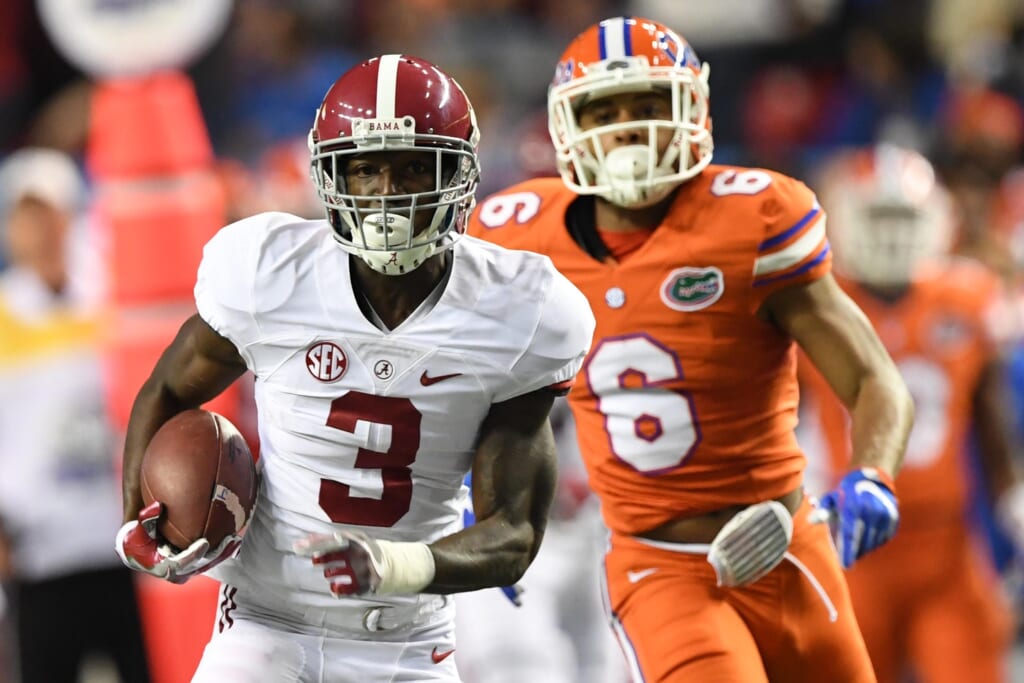
Heading into the combine, it was clear that Ridley needed to make a big impression. After all, he’s not a big receiver, coming in at 6-foot-1 and 189 pounds. And the receivers that have been under 200 pounds and drafted in Round 1 in recent years have all torched the track during their 40-yard dash.
Ridley didn’t run slow, but his time of 4.43 seconds was a bit surprising, especially since other, much bigger receivers, did better. But the real issue is that Ridley was otherwise very unimpressive as a raw athlete. He managed just 31 inches in his vertical and threw up a 9-foot-2 broad jump, showing average explosion. Even worse, he was not smooth on the field and showed shaky hands during the gauntlet drill.
The thing that sets Ridley apart on the field is that he’s a really strong route runner. But there’s a very good chance he’s being looked at now as a secondary receiver, rather than a true No. 1 threat, heading into the draft. And that would drop his stock significantly.
Tarvarus McFadden, cornerback, FSU
Coming off a rough 2017 season at Florida State that included a torn labrum and saw him intercept nary a pass, McFadden’s stock has plummeted during the pre-draft process. He ran a very poor 40 at the combine, coming in at 4.67 seconds. Then he was unable to significantly better that time during his pro day, being timed in the 4.6-second range, and generally failed to impress in any way.
This is a puzzling prospect to evaluate. Because in 2016, McFadden was one of the hottest freshmen in the nation. He earned All-American honors after intercepting eight passes, and everyone assumed he’d become one of the next great FSU defensive backs to dominate the NFL.
But right now, it’s looking like McFadden will fall into the middle of the draft, at best. Of course, he could prove to be an incredible steal. But right now teams are not exactly high on him as an impact starter.
Luke Falk, quarterback, Washington State
A quarterback who absolutely benefited from the system he played in during college, Falk had a very rough combine. He struggled to drive the ball down the field with any force and was wildly inaccurate. Word is that Falk had a much better showing at his pro day, which actually occurred at Utah State. He completed almost all his passes and showed better arm strength than he previously had, showing up having gained 13 pounds of muscle, too.
Still, it’s hard to envision Falk being selected any earlier than Round 3 in April. He could become a very solid backup in the NFL, and with luck he could become a mediocre starter. But that’s likely his ceiling, and he will be drafted accordingly.
Mark Andrews, tight end, Oklahoma
Before the 2017 season began, it was widely assumed that Andrews would be one of the top tight end prospects in the 2018 NFL Draft. He has ideal size (6-foot-5 and nearly 260 pounds) and was a seam-buster at Oklahoma, possessing the speed necessary to beat linebackers and safeties downfield.
But curiously, Andrews lost a step or three in his junior campaign compared to what we witnessed in 2016, when he was actually listed as a receiver and played like it. He posted average numbers at the combine overall but was the third-slowest tight end in the 3-cone drill. In a draft that features the likes of Mike Gesicki, who posted Vernon Davis-like numbers, it’s clear that Andrews’ stock is plummeting right now by comparison.
Arden Key, EDGE, LSU
Key’s final season at LSU was very akin to a player tanking during a contract year. He left the team for undisclosed reasons and dealt with injuries, leading to a very mediocre statistical campaign — 33 tackles and just 5.5 sacks.
Matt Miller of Bleacher Report wrote last November, “His off-field and injury history could push a once-top-10 talent way down the board.”
Then at the combine, Key refused to run the 40, which was very surprising. Especially since he showed up very skinny. And even worse, he wasn’t great on the field. Key has a chance to improve his stock at LSU’s pro day, but right now it’s looking like this player’s stock is tanking hard.
Rashaad Penny, running back, San Diego State
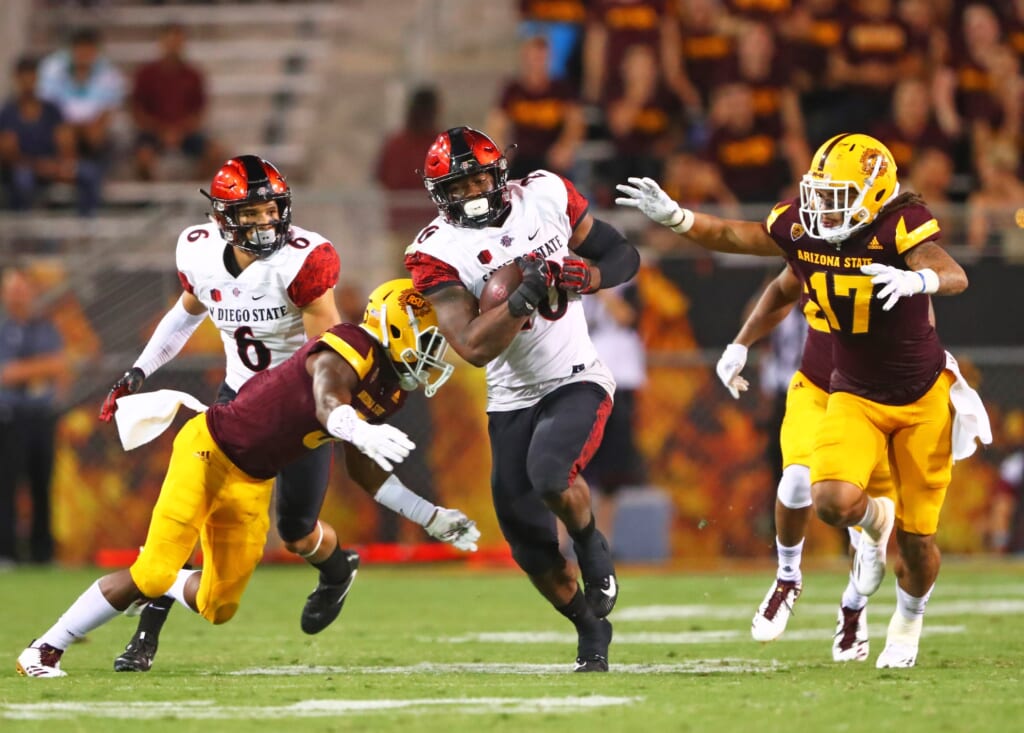
There are a few reasons we see Penny falling on draft day, despite his outstanding production at San Diego State last year (led the nation with 2,248 rushing yards).
First, Penny isn’t an experienced receiver or a great pass blocker, which could limit his role at the NFL level, especially early in his career. Secondly, he has an upright running style and struggles to break tackles because of it.
Penny did open some eyes running a 4.46-second 40 at the combine. His pure speed was a question mark. But given the overwhelming talent at the running back position, and the fact that he struggled against the top defenses he faced in 2017 (Boise State and Fresno State), we see him being selected in the latter half of Day 2 this April.
Will Hernandez, guard, UTEP
Put on the tape, and you see a guy who can move mountains. But here’s the rub: Hernandez could be seen as a player who doesn’t work well in zone-blocking schemes, and that accounts for about a third of the league these days.
Hernandez is somewhat like Mike Iupati, who ended up going No. 17 overall to the San Francisco 49ers back in 2010. He’s a mauler who has the potential to propel a running game into the next dimension. But like Iupati, he’s more brawn than finesse and relies more on power than mechanics.
It’s these limitations that could see Hernandez drop into the middle of Round 2 in the draft.
Billy Price, center, Ohio State
Good centers are hard to find, and Price is that. He won the Remington Trophy as the nation’s top center in 2017. At the least, he’s going to become an excellent guard, if the team that drafts him sees him excelling more in that role.
It’s a shame, really, that Price finds himself on this list. A player who was viewed as a first-round talent going into the combine, he tore his pectoral before he ever hit the field at Indianapolis, injuring himself during the bench press. The good news is that, after surgery, he’s reportedly expected to be ready for training camp. However, his injury will almost certainly drop his stock at least a bit.
Maurice Hurst, defensive tackle, Michigan
Like Price, Hurst is on this list through no fault of his own. During his combine physical, he was found to have a heart condition, which was reportedly similar to the one that caused Nick Fairley to prematurely end his NFL career. Cardiologists have cleared Hurst to continue football activities since then, but teams will likely be very wary about potential problems in the future.
From a pure football perspective, Hurst is a very strong prospect. Before his heart condition was diagnosed, he was seen by some as a first-rounder. He’s incredibly disruptive and powerful, even though he is a bit undersized at 6-foot-2 and 282 pounds. He’s a pure 4-3 defensive tackle, which limits where he will land, however. That aspect, on top of his heart condition, will likely cause Hurst to be selected well below his potential value.
Baker Mayfield, quarterback, Oklahoma
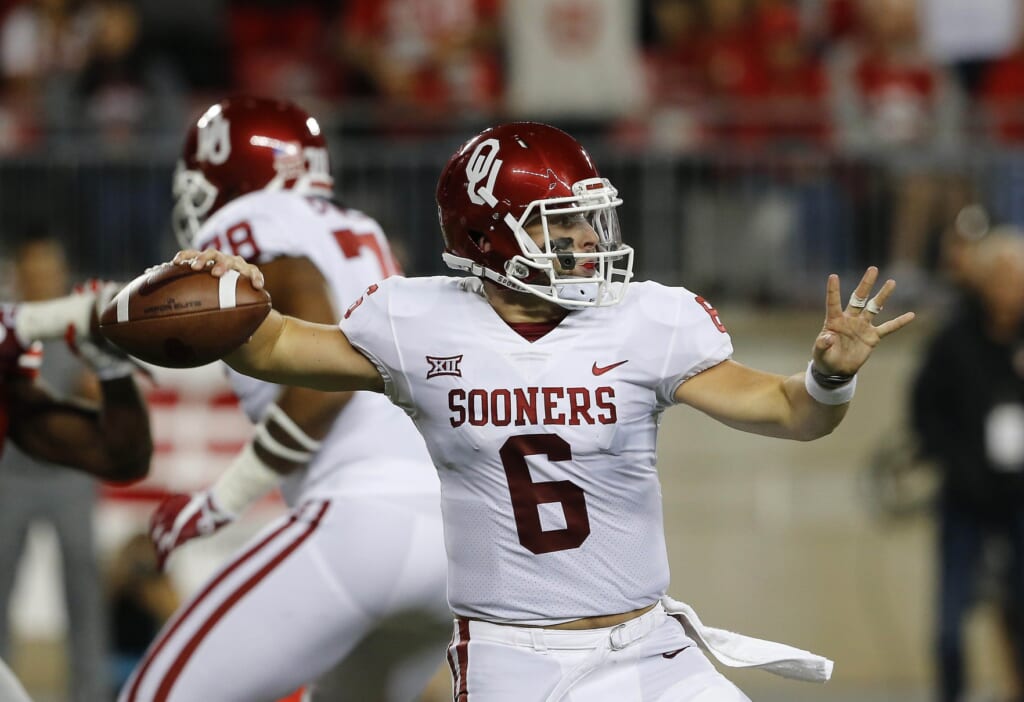
Of the four quarterbacks being viewed as the “top” of this year’s class, Mayfield is the most likely to take a tumble down the board in Round 1.
Sam Darnold and Josh Allen are both being mentioned as potential No. 1 overall picks to the Cleveland Browns. Josh Rosen’s biggest problem is that some people don’t like his attitude, but he has every other trait teams look for in a franchise passer.
This leaves Mayfield, who also has a perceived attitude problem (for some, anyway) and also is the shortest big-name quarterback prospect in this year’s draft. Last year’s Heisman winner, if he were a couple inches taller, would probably be a lock for the top pick in the draft. His accuracy, arm strength, anticipation and moxie all are huge positives.
But if anyone’s going to take a tumble out of the top 10, it’s going to be Mayfield. Which likely has a lot to do with why he’s not attending the draft.